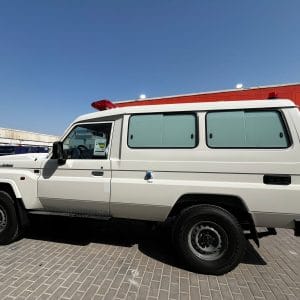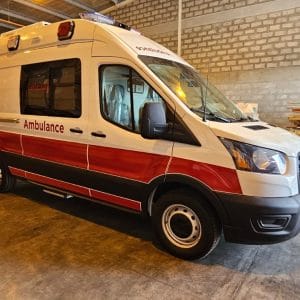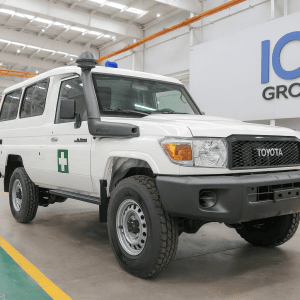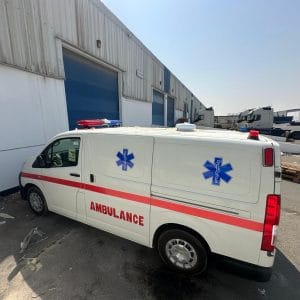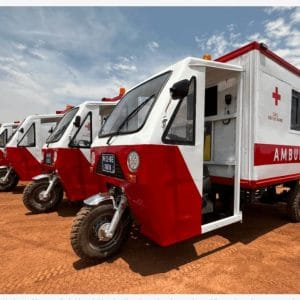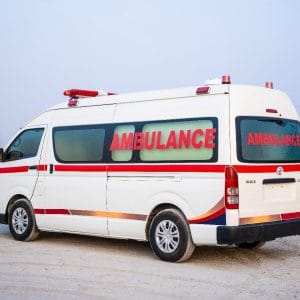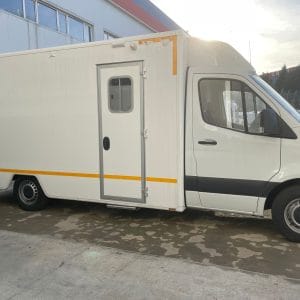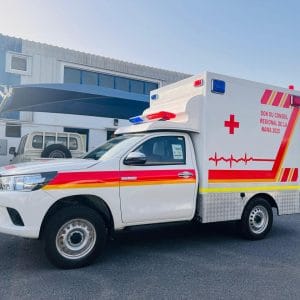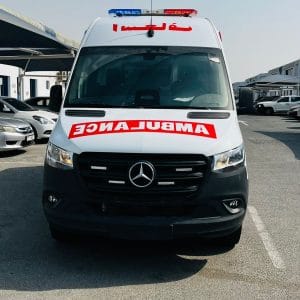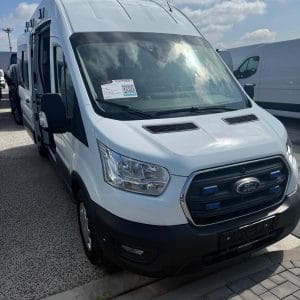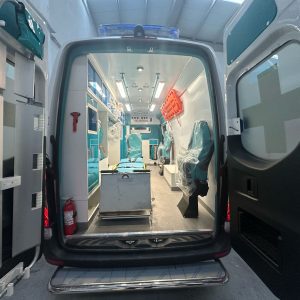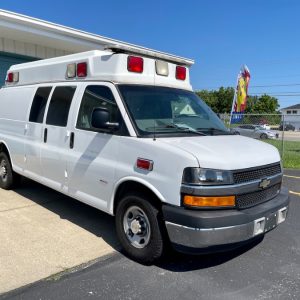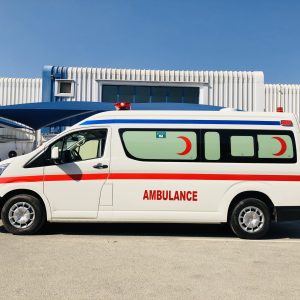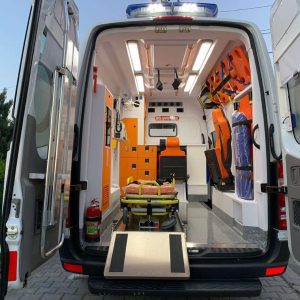1. Introduction
Firefighter Truck; Technical specifications of a firefighter truck equipped with 10,000 liters of water and 500 liters of foam, with Iveco 6×4 truck, represent a difficult classification request both in the literature and in the market, especially when it comes to the life of the technician. Because markets run faster every week due to developments in vehicle technologies, many vehicle manufacturers demand them by following cutting-edge technologies and, as a result, different classifications to suit operational requirements. Considering the scenario and specifications of the latest technologies and the latest Nigerian market, this review attempts to analyze the full details of the car’s specifications, the features of the firefighting car, the WIs and the tank, and the available accessories. As a result of this study, the specifications and prototypes have been developed for technical issuers.
Fire and action related to water and foam vehicles provide a serious air of understanding in the field. Firefighting and foam trees are segmentation systems for fire and air disorders. Firefighters are fighting fires and playing a key role in the process of developing fires that develop outside the activation. There are two types of fire – pool and feed. Regular water is used to extinguish extreme heat. Cooling is a method of reducing temperature. Therefore, by maintaining the capacity for more accuracy, the cooling factor through which a hat is required is a cooling factor. Optional, useful foam based on water, rated for 10-65. Extremely high levels of foam are also classified. Liquid or foam flow in and inside a siren. Pour water and foam on the fire depending on the ingredients. Before compressing, the storage tank has a certain amount of foam liquid (the foam is 1/float = 3) and water (3 md / 7).
2. 1. Overview of Firefighter Trucks
Firefighter trucks are a critical component of the fire prevention and management strategy of every municipality. The importance of fire, knowing no borders, clearly shows the importance of an integrated solution to prevent, contain, or extinguish it. The priority of any government or municipal administration should be to ensure the availability of firefighter trucks in all areas.
In the competitive world, firefighter trucks are used in almost every field to control and extinguish fires. Fire engine/firefighter trucks are primarily designed to carry firefighters to the scene of a fire and provide them with access to the fire. They also provide primary support, such as water supply and other equipment for firefighting. Additionally, they can be used for other applications, such as defense. It is worth mentioning that these trucks can carry tools weighing up to 500 kg.
Firefighter trucks designed for urban applications and the maintenance of roads and industrial facilities are generally smaller, while rural and wildland vehicles are generally much larger. Due to the high importance of preventing fires caused by air quality maintenance, deforestation, energy transportation, or animal fires, firefighter trucks should be as efficient as possible. Water tenders are used to deliver at least 5,000 liters per minute of water through a minimum of 1,500 m of 3-inch or larger hose.
Normally, firefighter trucks are divided into six categories: rural, brush, structural, rescue, emergency, and aircraft. Firefighters must respond to the fire area and access and place the truck at the scene of the fire. The size and shape of the engine/firefighter trucks depend on the type and age of the city or community. A firefighter truck manufacturer must offer the appropriate method to maintain the best exercise truck. Therefore, it is sometimes necessary to add additional technical specifications to the truck according to the service to be performed. This provides a better understanding of engine/firefighter trucks, firefighting strategy, and facility requirements.
Water tenders, also known as mobile water supply units or tanker tenders, are staffed by firefighters to help carry other firefighters and equipment to the scene of a fire. These tenders mainly support municipal and wildland-urban intermix regions. Some water tenders can be transportable, meaning they can be used in both forest and urban areas. Although these smaller tenders may have a comparatively small water stream, a pumper water man in a station with fire hose, as well as other water tenders available, can fill another pumper in case of larger fires, enabling multiple mouths. Smaller tenders and fast attacks sometimes have the same spectrum. The use of tenders in the fire and rescue pressurizing system and foam system is standard for larger water tenders and fast attack tenders. Luxury companies are also used for small-scale tenders. The water source can load the water tender with a hydrant, exhaust pit, or natural source, and some of them have a positive displacement pump that is used to fill it with water. A fire hydrant may also supply it.
2.1. 1.1 Purpose and Importance
Firefighter trucks are one of the most important vehicles for firefighter services. These vehicles have specialized equipment that provides the required service during an emergency. The equipment carried by these trucks should have the capacity to work for a longer time. The main job of a firefighter truck is to fulfill the water demands of a situation. When fire engines arrive at the fire, they fill up the water tanks of the fire. They will also provide water for drinking to the people who occasionally fight the fire. In the property conservation, almost more than 60% of the fire losses occur from the interior of the building fire, therefore the external attack of water is not appropriate. So the water supply for the required time becomes necessary. The truck should have water carrying capacity to fulfill the need for the time period to be protected by the action taken by the firefighter. It is important to analyze trucks with higher water and foam carrying capacity to provide requirements according to fire property, hazard, and location.
To fulfill the higher water carrying capacity of the trucks and other material selection on the basis of available space is a challenge in the design process of a vehicle. This paper deals with the technical analysis and selection of material, taking advantage of the IVECO vehicle’s dimensions. The 6×4 truck with a GVM of 32000 kg has emerged as an optimal vehicle with various dimensions. It can be equipped with a 10,000 liter water tank and a 500 liter foam tank in the area beneath the driver seat, i.e., tanker portion.
2.2. 1.2 Types of Firefighter Trucks
2.2. 1.2 Types of Firefighter Trucks
Firefighter trucks, which carry water for use in extinguishing fires, are a considerable cost in urban firefighting. They compose the biggest part of the fleet of firefighting vehicles within our country and the majority of developing and underdeveloped countries around the world. Therefore, efficiency, effectiveness from a firefighting point of view, practicality, and an economical approach are important during the procurement of the vehicles. For a fire truck to gain these features, it should be designed according to the place. Therefore, types and forms of fire trucks can be summarized into 13 different categories and 133 members.
The firefighter trucks on rear left-hand drive and 6×4 configuration are extensively used among the rescue teams in the world in terms of general technical properties. This firefighter truck is used for extinguishing fires, wildfires, big factory fires, garbage fires, oil fires, car fires, ship fires, forest and land fires, and saving of living land when local disasters, natural events, and war occur. Depending on these features such as access to expedited zones, being developed against default applications, not being easily punctured, and being easily screwed, it can also be used in debris/avalanche drilling and landslide activities other than fire extinguishing activities.
3. 2. Technical Specifications of the Iveco 6×4 Truck
For this study, an Iveco 6×4 truck was considered. According to the technical brochure of the Turkish representative, the technical specifications of the truck are given below:
Engine: 6 cylinders in line, FPT F2CE9685G * P, 510HP, 125Nm / 1300-1900rpm, 2800rpm Max 1st gear idle speed, engine brake (EXBR) maximum braking power of 321kW (455hp), emissions according to EURO VI emission directive, maximum 7550cm3 engine displacement, maximum 403 kW (560 hp) engine power, and maximum 2500Nm maximum torque.
Material: Cast iron cylinder, cylinder head, and an alloy of steel and aluminum.
Chassis and suspension: Chassis structure of the truck: Steel forgings and high-strength steel yield-point grade 900 MPa side members; front suspension with semi-elliptic parabolic leaf springs; rear suspension with semi-elliptic multileaf springs; double front and single rear stabilizer bar; monobloc NEF 100 8.7Lt 6-cylinder, 510 Hp, 2,500 Nm 10Euro6 engine; 16-speed (15 forward, 1 reverse) manual gearbox; Telligent auto-shift system; transfer case with gear-driven power take-off (PTO); low-range function; fording depth 0.8 m; 10t front and 23t tandem bogie capacities; driver-controlled differential locks; electronically controlled pneumatic suspension height adjustment; engine-driven air compressor for compressed air supply.
Transmission: Transmission type: ZF 16S2521 gearbox with Telligent auto-shift; Maximum torque transmission capacity: 2,500 Nm; Number of gears: 16 + 2 (15 forward, 1 reverse); Number of synchronizers: 6, synchromesh speed gears, approach switch for deep starting system 4.10: 1 axle ratio with additional PTO option; the maximum speed of the vehicle is 60km/h.
3.1. 2.1 Engine and Power
Engine and Power Engine type FPT NEF6E440, 6 cylinders in line, 4-stroke, water-cooled, turbocharged and intercooled, vertical MVE-3 fuel injection system with mechanical control is applied. 12 mm cylinder heads are manufactured on the same plane with the cylinders. Wet thermostat has 10,000 cycles of life. Its shaft and connecting rod bearings are bimetallic with 10,000 and 12,800 hours of design life respectively. Crankshaft rpm keeps 4500 rpm of life. Pistons are one-piece trunk and design specifically for 30-bar maximum cylinder pressure. The diagonally cooled piston bowls are polished rather than turned and rotated. The piston fists are cooled with oil in order to protect the piston crown piston-cylinder skirt clearance. Thermo-coated pistons designed especially for high temperatures account for almost 90% of the engine load.
The 24-valve and 4-valve structure within the cylinder heads provides high air and fuel circulation rates for engine power and torque characteristics. Vertical inline injection system is used at 900 bars in line with 500 bars air pressure for effective combustion. Low friction skirtless pistons with 103 ± 0.5 mm bore and 120 mm stroke allow efficient combustion chambers to be obtained and maximum cylinder pressure of 30 bar for powerful combustion. In this way, a high torque of 2220 Nm is offered to the service of driving safety, while the power of 440 kW (440 hp) is transferred to the vehicle. Rolling element condition and cylinder pressure sensors embedded on scavenge filters ensure that the engine protection requirement is met with precision and a high level of sensitivity. Turbocharging Boost pressure is designed as 3 bars absolute in line with the use of a maximum charge air pressure of 4.5 bars. The turbocharger ensures the best relationship between engine power and torque at all speeds. The electronic actuator at the cost of the turbocharger lets the variable nozzle ring optimize the energy spent by the gas to the turbocharger. The degas pipe integrated within the standard structure of the turbocharger provides the most compact cooling design. Turbocharger and special spark plug combination with cooled exhaust recirculation (EGR) system ensures that all vehicles produced with this engine offer the best action on all rail transport route types. In addition, it offers valuable advantages to the vehicle owner with high torque feature in passing capabilities and driving safety, as well as powerful torque even during difficult road transport conditions such as gradients.
3.2. 2.2 Chassis and Suspension
Chassis
Regarding the working components, the wheelbase is 3,750+1,350 mm, leading to a total length of 7 meters. The specific configuration of the 3rd axle allows for a reduction in the inside turning radius of the vehicle body. The outer surface of the vehicle body is treated with water-based paints that provide a high gloss. The cabin is equipped with toolboxes incorporated in the rear section of the crew cabin. There is an accessories’ storage cabinet on the left crew cabin. All storage areas are equipped with inbuilt drains. The internal configuration of the bodywork was developed by the BFP specialists to comply with the highest number of BREPS required by the standard. All pumping and finishing components and accessories are under the monitor of PLC controlling the whole operation, with a 12″ color touch-screen control panel with GPS coordinates sending system display integrated. Two hinged doors are located on the left vehicle body and are equipped with automatic lighting.
Suspension
The vehicle is four-wheel drive and is equipped with spring and shock absorber twin suspension, with telescopic absorbers with torsion bars for the 1st and 2nd axles. The rear axles are equipped with twin posteriores with stabilizer bar. The off-road capability of the vehicle chassis, plus the leaf spring-shackle with the extra low position of the rear axles above the vehicle chassis, allows for great mobility by enhancing suspension capacity. The 9 or 10 leaves are arranged for better damping capabilities on each side, optimizing suspension performance and driver comfort, ensuring greater surface tire contact, a feature crucial for firefighting operations. The exclusive inscription on the right and left vehicle bodywork displays the foam and water tank sizes available on the vehicle.
3.3. 2.3 Transmission System
The Iveco 6×4 truck is equipped with the ZF 12 TX 2520 TO transmission (Torque Converter). This transmission, which is integrated directly to the engine, is capable of generating a maximum power of 420kW at the end of the gearbox. The gearbox has the following gear ratios: First gear has 8.64%, Third gear has 6%, while top gear has 2.86% of speed per engine speed.
The high-low gear shift is provided thanks to the main shaft’s direct connection to one-way synchronous clutches. The main gearbox shafts accelerate the vehicle with the help of a torque converter, and a direct connection is also provided from the engine to the wheels. In the first gear of the torque converter, the turbine speed of the vehicle acting on the pump of the torque converter yields 8.64% of the turbine speed. The integrated retarder reduces the overheating of the service brake by providing 600kW of power.
Moreover, the front and rear axles are manufactured according to the 2.3 ZF technical specifications, as well as a 6.4:1 final drive ratio and a 3400 mm long hollow shaft for the connection of the axles. The transmission system of the vehicle enables it to provide a continuous driving experience by safely converting the power generated by the engine to speed. In view of this, the transmission system is divided into 4 gears as main and auxiliary transmission, engaged by pneumatic control. The following components are the main parts that make up the transmission system of an Iveco 6×4 truck: Automatic First Gear, Synchronizer Device, Change Speed Group, Differential Single Reduction Planetary Final Drive. The specifications of the transmission system of the vehicle are shown in Table 3.3.2.3.1.
4. 3. Water and Foam Capacity
4.3. Water and Foam Capacity
4.3.1. Water Capacity
A total of 10,000 liters of water with a level indicator system will be placed on the truck to be used in the firefighting process. The tank includes anti-surge walls and it is intended to prevent water from moving when the truck is accelerating, braking or turning. The water level in the tank will be checked from the driver’s seat by a visual indicator. The tank will also be able to be emptied in a short time from the bottom.
4.3.1.1. Water Tank Structure Material: Sheet metal Dimensions: 10,000 liters
4.3.2. Foam Capacity
For the efficient use of water in fires, sometimes it is necessary to use a variety of chemicals such as foam and in different foam rate ratios. In addition, there are water with the expansion coefficient of 3% and Total Flooding foams on the market today. In addition to the best foam manufacturer in the world, one of the exclusive suppliers of a Turkish company, the foam rate will be 3%, and the product will be used when necessary after a field test is performed.
4.3.2.1. Low-Expansion Foam Tank
The finely-stainless works tank will be manufactured using #304 steel with precision TIG welding. The tank has the maximum air pressure to be 10 bar and will possess a capacity of 500 liters of foam application. The tank will be equipped with an air compressor that will specifically supply air to the 500 liter foam tank. The air pressure in the system will be monitored to display the amount of air in the system to the operator. This pressure will be registered electronically in the cab. This pressure will be adjustable according to the preference of the user. In addition, the extinguishing water tank will be equipped with a water jet. A total of 10,000 liters of water and 500 liters of foam with a focus on advanced technical where consumption of electricity of machine reduced to minimum and of a truck that will meet all the requirements of firefighting will be put in the service of taking municipality’s priorities.
4.1. 3.1 Water Tank Specifications
4.1.3.1 Water tank construction
– Material: Aluminum. – Cross-section: Oval. – Manholes: (4) for the filling and the inspection of the interior of the tank. Protection: All shafts with iron butterfly. – Hatch: Located on top of the tank and with protection by means of a folding blind cover attached to one of the shafts. – Low hatch: Special anti-blowing design located in the low center of the tank to guarantee the full emptying of the tank fluid.
4.1.4 Maximum capacity and useful volume of the water tank in liters – Maximum capacity: 10,000 liters. – Useful volume: 10,000 liters.
4.1.5 Water tank support frame The support frame that receives the tank consists of a protective element at the bottom of the tank in order to offer it effective protection against possible shocks that may occur in heavy commercial work. In addition, the tank structure is designed to allow its location above the vehicle’s axes, with a very low center of gravity and to also allow a good distribution of weight on each axis/front and rear.
Table 3: General characteristics of the tank specifications Manufacturer: Rala Number of compartments: 1 Tank dimensions: 4300 x 2100 x 1750 mm Cross-section: Oval Total tank capacity: 10,000 liters Example with 10,000-liter tank % A: Fifth of the tank emptied in seconds: 25 % B: Fifth of the tank emptied in seconds: 30 % C: Fifth of the tank emptied in seconds: 35
4.2. 3.2 Foam Tank Specifications
4.2.3.2 Foam Tank Specifications
The fire truck carries 500 liters of Class B foam. It is used to extinguish fires caused by combustible liquids, which are commonly found stored in tanks in urban areas. Storing and protecting such a large volume of water would be very difficult. Therefore, it is necessary to have a sufficient area of land and a certain distance from the city for warehouses where the water is stored for tank elution. This larger area of land and distance is required to protect the larger mass. Instead of polluting the woods and soil and incurring landfill expenses to dispose of waste foam, the use of foam can be more common in forest fire areas.
Foam decreases the mixing of water purity, suppresses flames, and extinguishes fires by cooling the liquid surface. It has a mass of 35kg and is twice as strong, cooling the ignited surface and expanding the surface area. Foam reacts with the grid structure and sizes. Aqueous film-forming foam (AFFF) is a chemical used to put out fires. Fluoro-protein foam falls into the category of protein foams. Aqueous film-forming foam (AFFF) foam mixtures are resistant to asbestos, non-toxic, and have a long-lasting life. Organic protein foam (OF) allows for good spreading, has a low storage temperature, and has a long shelf life. Because the water percentage is high, the production costs are low. In this case, the most efficient fire-fighting will be achieved, especially in marine, mobile, extinguishing systems, and the protection of industrial oil refineries. It has a smoother finish than AFFF and is effective against heavy liquid fuels in the paper, textile, and gasoline extraction industry. It is eco-friendly because it is biodegradable and leaves no residue. Foam polyoxymethylene (P) can be stored cold up to 15°C without sliding waste and can be applied as a deep curtain.
5. 4. Pumping System
Pumping system The vehicle is equipped with one unit of a portable or built-in, centrifugal, and rear mount pump. It is interconnected with the engine’s power through a power take-off and has a direct action. It includes a cooler water box, water discharge (refractory) that includes a pipe feeding the left and right sideways of the vehicle, and a pipe feeding the equipment with a reducing valve. The pump control system includes an auxiliary panel located in the cab with controls, control lever, and the whole set is marked, providing precise identification of the function or use. The control of the pump operation, releasing pressure for the application of foam, is unique in the world, with an exclusive Fire-friendly IVTM patent, developed for the BOM EUFOR SHELF truck, being safer for the firefighter and more efficient against the flame.
There is a pump designed using CAD technology, installed in parallel to the engine, which provides a pumping capacity of 4,000 L/min at 10 bar, drawing water from rivers, springs, lakes, and hydrants. It is presented as an excellent set that accepts rapid or manual priming and has the equipment for drafting the vehicle using a failure pump with a connector and valve attached to guide the flow of the pump set. The vehicle has a release valve or water relief valve and a check valve to check the fluid circulation when the pressure in the tube is lower than the pressure in the tank. This type of nozzle is intended for use against flames and for the possible reduction of vapors with a high capacity of 1,000 liters/min (smoke and fire ball on the fire). With the 1,000 L/min nozzle, it is also possible to use 600 liters/min (water mist) for extinguishing A and B class fires. The panel is equipped with a computer and operates on energy and uses a smaller flow of 250-350 liters/min. The pressure required by the system is 12 atm, and it can also be increased up to 20 atm. The panel has a release and display system, pressure gauge, nozzle design, and the truck is a complete chain operating with a fire-extinguishing water.
5.1. 4.1 Types of Pumps Used
The types of active and auxiliary pumps that are used are explained in detail here. The primary pump ensures the high-pressure water flow required for the firefighting nozzles or hoses, and the secondary pump is used to pump up the water into the tank as well as to pump up the foam additive balanced to the water flow through the pipeline.
The following are passive and auxiliary pumps used in the pump and roll system in order to increase system efficiency. The characteristics of the pumps used in a firefighting system are given below.
4.1.1 Centrifugal Pump Centrifugal pumps are the machines that are designed as a tire pump inside the pump housing as shown in Figure 1. This pump uses electromagnetic energy to convert mechanical energy into heat energy by increasing the water’s thermal energy. Centrifugal pumps separate these functions into two basic mechanics. The centrifugal machine uses the tire technique to convert energy to kinetic before the change in liquid energy.
4.1.2 Gear Pump In gear pumps, the gears rotate each other inside the specially designed gearbox, the driving gear (drive gear) rotates as shown in Figure 2. During the rotation of the driving gear, gear 1 flattens the containers on the internal side of the existing liquid in the casing (pump body) and under the pressure, leaving less room for the increased liquid to be attached, and it is pushed into the pressure cells. At the same time, with the increasing pressure, liquid is pushed into the pressure cells through the 2nd gear that moves the driven gear in the opposite direction, noted as a driven gear.
5.2. 4.2 Pumping Capacity and Pressure
5.2.4.2 Pumping Capacity and Pressure
The total water and water + foam ranges are determined in the optimum pumping flow analysis section. The water flow rate is between 1000L/s-4200L/s, and the foam flow rate is between 50L/s-420L/s. 1000 liters of water at a time and 50 liters of foam capacity to the site within the first 12 minutes emphasizes the importance of the fact that the total range is also between 1200 liters and 2220 liters. Existing fire trucks are modeled on their technical drawings and airless simulations by implementing the flow values of the system determined in the 5.2.4.1 subsection. The pump is attached to the truck. By taking the power consumed from the pump, the change in fuel consumption/m, the thrust force of the pump, the change in the truck road resistance and the pulling force are examined. Since the pump output data is not included in the projects of the trucks available, in this study, the technical result set of the 10,000L water capacity and 5,000L foam capacity vehicle on the market was collected and details of the pump output were consulted.
The main specifications of the pump are given below: The flow rates of the pump are divided into two according to water and foam. Water flow rate is 3800L/min (63.33L/s) and foam flow is 190L/min (3.17L/s) values. It is stated that the energy source of the pump is via a differential geo driven from the truck power take-off. In this case, it is aimed to identify the shaft power of the pump. In addition, the system and pump pressures are given below as 10 bar and 6.5 bar, respectively. In this case, the pressure values to be taken into account in the airless simulation to be done in the next part of this research have been determined.
6. 5. Special Features and Equipment
6.5. Special Features and Equipment
The vehicle is fitted with LED flashlights (covered) in three different sequence lighting and control systems: blue, red, and color fixed or warning based function according to ET15 standards.
The high level, with a length of 170 cm, and 20 sound tones warning functions are made of aluminum with a stainless cover of the optical LED system equipped with a siren with a built-in power of 320 Watt and 150 Watt. The lightbar is specially designed and manufactured to show 170 cm dimensions, 20 penalties alto LED Optical LED system appears to be made of aluminum covers, as part of stainless steel lighting systems with controls built-in siren from 100 Watt to 18 different siren recursively combined warning functions. There are 5 different simultaneous warnings for LED × 4 installed on each side of the vehicle, an emergency philosophy applied, and a fully equipped solely aimed at lighting systems. The siren has different simultaneous warning and with the new control unit fitted in Kuzgun, advantage in production and coordination lights and sounds can be more easily created.
The lighting system can be managed from any logical component on the control panel. Similarly, the firefighter switch in the control panel can also be switched on, and the status and malfunction can be viewed on the control panel screen. There is a camera system that can be turned on and dropped back to the back of the vehicle. The engine work, reverse maneuver thermostat operates when the reverse gear is opened and outputs the incoming images from the cameras behind the screen in normal standby mode and working video recording options on demand. In addition, a monitor with a screen in the same location as the hose in the pump system is installed in case an image is required for the person who will shoot the hose at the rear with the basics and their non-reflective glasses from the sun. Specially designed and mounted on the unmanned air drums. The attached carrying arm of the basket support contains a cartridge with a fire-extinguishing and clear water cover of 360-600 liters per minute. At the camera, intelligent hybrid (infrared) camera, 40x optical 12 digital zoom works, and the image is referenced in the cab and rear TNA workstation. Within itself, collision and movement sensors and the following option to use the vehicle’s own carrying arm controller have been integrated into the main cabin. At the top of the basket, 200 kg is capable of carrying remotely thanks to the second control unit. Communication with the operator is provided by a 7-inch LCD monitor and wireless earpiece. The live broadcast is calculated by the user, and at 6 bar, the pipe throwing range is 22 meters.
6.1. 5.1 Lighting and Siren Systems
Lighting system selected for the vehicle: – Emergency team and signature lamps. – Emergency stop fog, flash lights. – Parking light front and side. – Lantern rear.
Enabling visibility for operation: – Side flash alerters to allow passage of the vehicle. – Progressive backrest running lights for vehicular visual, thereby signaling and scheming tailgaters. – Projector bars for excellent vision, differ from turning on mud, make-believe, and law enforcement tactics. – Bottom base lanterns, intended for flexibility of the earth. Projector driver reflects light in a hole, acting as an obstacle, ensuring awareness of the place, the vehicles of nature to darken. – Lantern projector top front, apart to ensure the resulting of the route, whether vehicles in the direction of the opposite or the front, provides awareness and topological data of each, so that in the long run there will be fires of tjau and illumination of the area. – Spread lantern, aimed at the convenience of enveloping. Use columned design with lower visual foreground and more conceptual ident.
The integrated emergency sound system is important for the overall features of the fire fighting warning siren. The integrated warning siren provides a personal alert to the ground, synchronized sounds to ensure the convenience of the sirens around the vehicle, with the maximum volume provided by low noise levels to comfort the equipment.
6.2. 5.2 Communication Devices
6.2. 5.2.1 HF VHF UHF Radio Device: An HF VHF UHF radio device with a minimum memory of 128 channels, 10 memory groups. It shall be transmitted at a frequency of 136.975; shall receive at a frequency of 151.300; frequency range should be between 29-9999 MHz (mainly 29-512 MHz). It shall have CTCSS, DCS, DTMF, and 5-tone signaling systems. The radio shall have a single antenna output; a transmitting power of 25W; 20,000-channel SIM card insertion and activation from 35-50 Hz; an IP-67 rating and 5-person speaker and MILCOM connector. In addition, there will be an additional unit approved by the AE to install at the control panel. Due to the determination of the system to be used in the fire brigade, the procurement and application tender is done by the ministry’s auxiliary service units. The technical specifications related to the communication devices in the truck used by the fire brigade in Syria with a 10,000-liter water and 500-liter foam tank produced by TSP having (24-367) wheelbase on IVECO 6×4 tipper chassis. In the fire brigade, coordination and communication with rescue personnel are essential. It is very important for this rescue and firefighting technical equipment to be assured on the truck.
GPS device with GIP, PPS, satellite receiver, 10MHz bidirectional signal interface (it allows both receive and transmit, as an example COM2 on RS232) and display screen. High-dollar device is recommended because of this, it is necessary to check the expenses with allocation of a good area for the GPS device, sending telecommunication prices to the attention of the personnel as an administrative gas team at the General Directorate and taking permission just after receiving the permission, and necessary without delaying the present situation. The tender of the communication device is a service procurement. It is not suitable to make a regulation for the service. In terms of public administration, it is necessary to look for our technical specification to fully lock on a communication device to be adapted to this communication equipment. In particular, in countries with multiple political and economic problems, such production should be ensured with high-security accessories and specifically designed with a robust regulatory structure.



